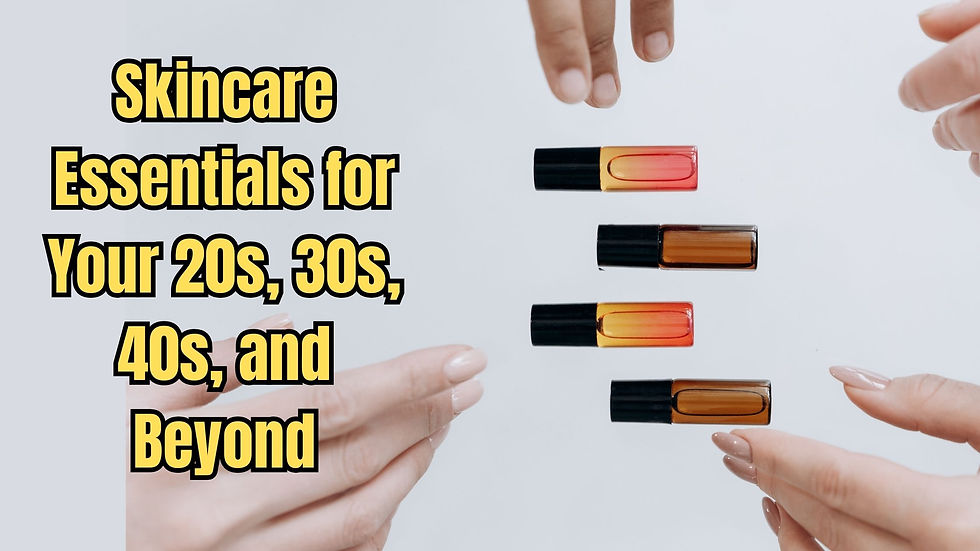How to Address Rosacea and Redness-Prone Skin
- Akram Beauty Booth
- Dec 17, 2024
- 4 min read
Updated: Jan 1

Rosacea and redness-prone skin can be frustrating to manage, but with the right approach, it's possible to reduce irritation, calm flare-ups, and achieve a more even complexion. Whether you suffer from rosacea, sensitive skin, or simply experience redness due to environmental factors, understanding how to care for your skin can make a significant difference. In this blog post, we’ll explore the causes of rosacea and redness-prone skin, tips for managing these conditions, and the best skincare ingredients to use.
What is Rosacea and Redness-Prone Skin?
Rosacea is a common skin condition that causes redness, visible blood vessels, and sometimes bumps or pimples on the face. It usually affects areas like the cheeks, nose, chin, and forehead, but it can also extend to other parts of the face. While the exact cause of rosacea isn’t fully understood, it’s believed to be related to genetics, an overactive immune system, and environmental triggers.
Redness-prone skin, on the other hand, refers to skin that is easily irritated, prone to flushing, or sensitive to certain skincare products, temperatures, or environmental factors. While redness-prone skin might not have the same intensity or chronic nature as rosacea, it can still cause discomfort and affect the skin’s appearance.
Causes of Rosacea and Redness-Prone Skin
Several factors contribute to the development of rosacea and redness-prone skin. These include:
Genetics: A family history of rosacea can increase your likelihood of developing it.
Environmental Triggers: Sun exposure, extreme temperatures, hot drinks, and spicy foods are common triggers for rosacea and redness-prone skin.
Skin Sensitivity: Overuse of certain skincare products or harsh chemicals can make your skin more susceptible to redness.
Inflammation: Conditions that cause inflammation, like acne or eczema, can lead to redness and sensitivity.
Blood Vessel Dilation: In rosacea, blood vessels in the skin can dilate, causing a flushed or red appearance.
How to Manage Rosacea and Redness-Prone Skin
Managing rosacea and redness-prone skin requires a gentle and consistent skincare routine. Here are some essential tips for calming irritation and reducing redness:
1. Choose Gentle, Non-Irritating Skincare Products
One of the most important steps in managing rosacea and redness-prone skin is to choose products that are gentle and free from harsh chemicals. Avoid products that contain:
Fragrances: Fragrances can irritate sensitive skin, leading to flare-ups and increased redness.
Alcohol: Alcohol-based products can be drying and aggravate the skin’s natural barrier, making redness worse.
Harsh Exfoliants: Physical exfoliants (scrubs) and chemical exfoliants with high acidity can be too aggressive on sensitive skin. Opt for gentle exfoliants with mild exfoliating ingredients like lactic acid or fruit enzymes.
Strong Retinoids: While retinoids can be effective for acne and anti-aging, they can be irritating for those with rosacea. Consider gentler alternatives like bakuchiol.
2. Use Anti-Inflammatory Ingredients
Certain ingredients can help reduce inflammation and calm redness. Look for skincare products that contain the following:
Niacinamide (Vitamin B3): Niacinamide is an anti-inflammatory agent that can help reduce redness and strengthen the skin’s barrier.
Centella Asiatica (Cica): This plant extract has soothing properties and helps repair the skin’s barrier, making it ideal for calming redness and irritation.
Aloe Vera: Known for its cooling and anti-inflammatory properties, aloe vera can help calm the skin and reduce redness.
Green Tea Extract: Green tea contains antioxidants that reduce inflammation and protect the skin from environmental stressors.
3. Hydrate and Strengthen Your Skin Barrier
Rosacea and redness-prone skin are often associated with a weakened skin barrier, which makes the skin more vulnerable to irritation and redness. To help repair and strengthen the skin barrier:
Use Moisturizers: Opt for fragrance-free, hydrating moisturizers that contain ceramides, hyaluronic acid, and glycerin. These ingredients help lock in moisture and reinforce the skin’s protective barrier.
Avoid Over-Washing: Over-washing your face can strip away natural oils, leaving your skin dry and more prone to redness. Cleanse your face with a mild, hydrating cleanser that doesn’t contain sulfates.
Hydrate Internally: Drinking plenty of water throughout the day helps keep your skin hydrated from within.
4. Avoid Triggers
For many people with rosacea and redness-prone skin, certain triggers can worsen flare-ups. While triggers can vary from person to person, some common ones include:
Sun Exposure: Sunlight is one of the most common triggers for rosacea. Protect your skin with a broad-spectrum sunscreen of SPF 30 or higher daily, even on cloudy days.
Hot Water: Hot showers and washing your face with hot water can dilate blood vessels and worsen redness. Use lukewarm water instead.
Spicy Foods and Alcohol: Foods like spicy dishes and alcohol, especially red wine, can trigger flushing. Try to avoid or limit consumption of these items.
Extreme Weather: Cold weather, wind, and heat can all irritate the skin. Wear protective clothing like scarves or hats in harsh weather, and use a thicker moisturizer in colder months.
5. Consider Prescription Treatments (For Rosacea)
If you suffer from rosacea and over-the-counter treatments aren’t providing relief, it may be time to consult a dermatologist. Some prescription treatments for rosacea include:
Topical Medications: Metronidazole and azelaic acid are commonly prescribed topical treatments that reduce inflammation and control rosacea symptoms.
Oral Medications: In some cases, oral antibiotics like doxycycline can help manage rosacea symptoms, especially if there is significant inflammation.
Laser Therapy: For more persistent redness and visible blood vessels, a dermatologist may recommend laser therapy to reduce redness and improve the appearance of the skin.
Conclusion
Rosacea and redness-prone skin can be challenging to manage, but with the right approach, you can effectively reduce irritation and achieve a more even complexion. By selecting gentle skincare products, using anti-inflammatory ingredients, and avoiding common triggers, you can calm your skin and keep redness under control. If you have rosacea, seeking guidance from a dermatologist and exploring prescription treatments can also provide additional relief. With patience and consistent care, it’s possible to address rosacea and redness-prone skin for a healthier, calmer complexion.





Comments